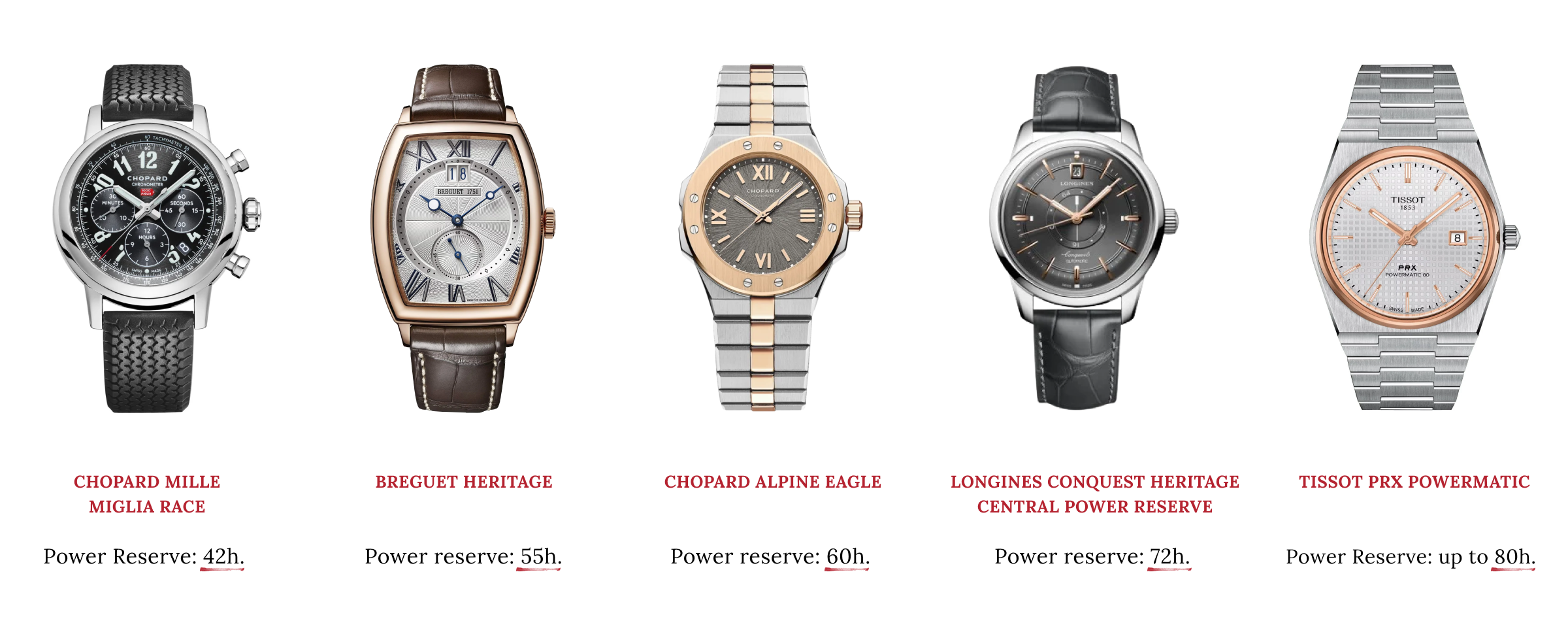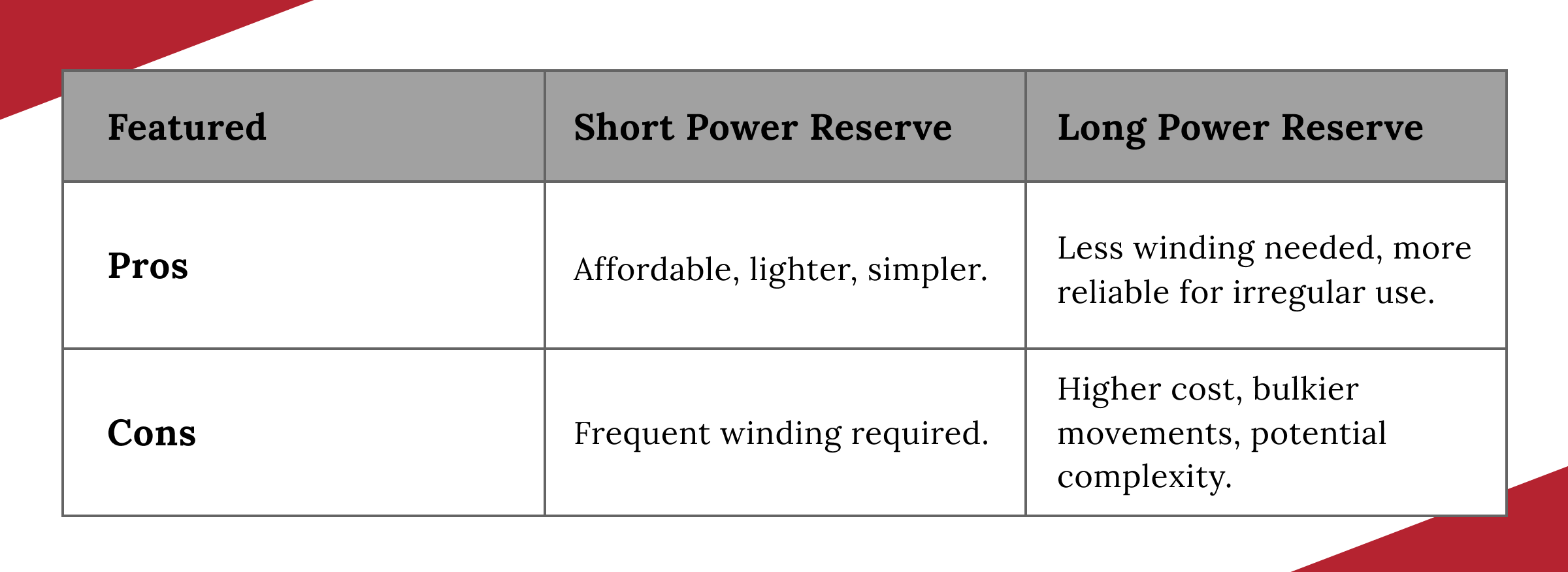Wind It Up! What You Need to Know About Power Reserve
Watches are more than just tools to tell time—they are intricate pieces of craftsmanship. One of the most important features to understand when choosing a watch is the power reserve. Whether you’re a daily wearer, a collector, or someone who loves the mechanics of timepieces, knowing the ins and outs of power reserve can help you make the right choice.
What is a Power Reserve in Watches?
The power reserve of a watch refers to how long it can run without needing to be wound or worn. Essentially, the power reserve is the time a fully wound watch can operate before the watch’s mainspring energy is completely depleted. For example, if you have a 70-hour power reserve watch, it will keep ticking for nearly three days after winding.
For automatic watches, the power reserve depends on wrist movement to wind the mainspring. Knowing your habits will help you choose a watch that fits your lifestyle.
How Your Watch Stores and Uses Energy
The heart of every mechanical watch is the watch mainspring energy stored in a coiled wire. When wound, either manually or through wrist motion in automatic watches, the mainspring stores potential energy that is gradually released to power the gears.
For manual-wind watches, you control the winding frequency. In contrast, automatics rely on a rotor to keep the mainspring wound during wear. This difference in winding methods affects the manual wind vs. automatic power reserve experience. While automatic watches provide convenience, manual watches offer a tactile connection to timekeeping.
How Long Can a Watch Keep Ticking?
The running time of a watch depends on its movement design and the efficiency of its mainspring and barrel.
- 24-48 Hours: Found in many entry-level and vintage watches.
- 70-Hours: Popular among modern enthusiasts who want longer durations.
- 80-Hours: Represent a new standard in advanced horology, perfect for travellers or collectors.
Specialized timepieces can offer over 100 hours, but they are often pricier due to their complex movements.
Tip: If you switch watches often or leave them unworn for days, a longer power reserve can be very practical.
Power Reserve Indicators: Your Watch’s Fuel Gauge
A power reserve indicator is a feature on some watches that displays the remaining energy stored in the mainspring. This is especially helpful in managing winding intervals and ensuring your watch stays accurate.
Key Benefits
- Convenience: The indicator allows you to easily track remaining energy, eliminating guesswork and ensuring consistent performance.
- Maintenance: It helps prevent overwinding. (Modern automatic watches typically have safeguards, but manual watches require careful winding to avoid damage.)
- Practicality: Particularly useful for those who rotate between watches, as it reduces the need for frequent winding and adjustments.
Who Benefits from a Long Power Reserve?
While a standard power reserve is sufficient for daily wearers, certain groups can benefit greatly from watches designed for optimal energy retention:
- Occasional Wearers: If you alternate between watches, having one with an extended reserve means it will still be running when you return to it.
- Collectors: Managing a collection is easier when watches with longer reserves require less frequent winding or adjustment.
- Travellers: With an extended reserve, you can leave your watch unworn for days without losing accuracy.
Energy Storage in Mechanical vs Automatic Watches
- Mechanical Watches: These require manual winding to tighten the mainspring, making power reserve critical. Forgetting to wind the watch can leave it inactive.
- Automatic Watches: The rotor winds the mainspring while worn, but if left unworn for a few days, the energy reserve becomes crucial to keep it running until you wear it again.
Regardless of type, watches with extended energy reserves reduce the need for frequent winding, making them a practical choice for many.
Short vs. Long Power Reserve: Pros and Cons
Keep in mind that while long power reserve watches offer convenience, they often come with trade-offs such as thicker cases or a higher price tag. This is why not all timepieces aim for the longest energy reserve—it’s about finding the right balance.
Debunking Power Reserve Myths
It’s easy to fall for misconceptions about power reserve. Let’s clear up a few:
- Myth: Longer energy reserves are always better.
- Fact: Extended reserves often come at the cost of increased complexity and size. Choose a watch based on your actual needs.
- Myth: You can overwind an automatic watch.
- Fact: Modern watches are designed with mechanisms to prevent overwinding, though manual watches still require care.
- Myth: Power reserve indicators are unnecessary.
- Fact: A power reserve indicator watch is invaluable for monitoring energy levels and avoiding inconvenient stops.
Practical Tips for Maximizing Power Reserve
To ensure optimal performance, follow these tips:
- Winding Habits: Wind your manual watch daily at the same time. For automatics, ensure regular wear or use a watch winder.
- Service Regularly: Worn components can reduce power reserve efficiency.
- Avoid Overwinding: Even with safeguards, gentle winding is best for longevity.
Choosing the Right Power Reserve
When choosing a timepiece, consider your lifestyle:
- Daily Use: A standard energy reserve of 48 hours is usually enough for regular wear.
- Occasional Use: A watch with a 70-hour energy capacity or more offers greater reliability when worn less frequently.
- For Collectors: Timepieces with an 80-hour or longer autonomy provide flexibility, especially when paired with an energy reserve indicator to track the remaining charge.
Understanding the meaning of a watch’s energy reserve is crucial for making an informed decision. Whether you’re after a simple, elegant piece or look for luxury timepieces with extended energy capacity for practicality, aligning your choice with your lifestyle is key. Remember, a watch is more than just a way to tell time—it’s a reflection of your style and precision.


